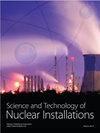巴拉卡核电站乏燃料管理的技术选择和成本估算
IF 0.9
4区 工程技术
Q3 NUCLEAR SCIENCE & TECHNOLOGY
引用次数: 0
摘要
在乏核燃料临时储存的规划和管理中,所涉及的技术和经济参数在提高储存系统的效率方面发挥着重要作用。最佳参数将降低阿联酋等核能国家的总经济成本。本研究评估了各种结构和时间表的设计性能和经济可行性,以确定乏核燃料管理的最佳参数组合。随着各种存储技术安排的引入和存储系统设计的单位预期成本,我们评估了八个主要场景,每个场景都基于技术和经济问题进行了成本分析。我们根据这些存储技术的使用情况进行了大量计算,并考虑了它们的投资成本。这些计算与净现值法一致,并使用MS Project和MATLAB软件程序进行,考虑了乏燃料池的容量和将转移到干式储存设施的乏核燃料(SNF)的量。一旦它们充分冷却,乏核燃料将被储存在水池储存设施中。结果表明,与使用永久处置设施(PDF)相比,应用集中干式储存(CDS)系统策略在经济上不是可行的解决方案(除非可变投资成本降低或改变)。最佳策略包括在第一个20 反应堆开始永久停堆的年份。20之后 几年后,乏燃料被转移到PDF中。与其他策略相比,该策略还使总成本降低了20.9%至26.1%。拟议战略的总成本约为43.07亿美元。燃料储存的持续时间和投资成本,特别是可变投资成本,直接影响设施储存的选择。本文章由计算机程序翻译,如有差异,请以英文原文为准。
Technical Options and Cost Estimates for Spent Nuclear Fuel Management at the Barakah Nuclear Power Plants
In the planning and management of the interim storage of spent nuclear fuel, the technical and economic parameters that are involved have a significant role in increasing the efficiency of the storage system. Optimal parameters will reduce the total economic costs for countries embarking on nuclear energy, such as the UAE. This study evaluated the design performance and economic feasibility of various structures and schedules, to determine an optimal combination of parameters for the management of spent nuclear fuel. With the introduction of various storage technology arrangements and expected costs per unit for the storage system design, we evaluated eight major scenarios, each with a cost analysis based on technological and economic issues. We executed a number of calculations based on the use of these storage technologies, and considered their investment costs. These calculations, which were aligned with the net present value approach and conducted using MS Project and MATLAB software programs, considered the capacities of the spent fuel pools and the amount of spent nuclear fuel (SNF) that will be transferred to dry storage facilities. As soon as they sufficiently cool, the spent nuclear fuel is to be stored in a pool storage facility. The results show that applying a centralized dry storage (CDS) system strategy is not an economically feasible solution, compared with using a permanent disposal facility (PDF) (unless the variable investment cost is reduced or changed). The optimal strategy involves operating a spent fuel pool island (SFPI) storage after the first 20 years of the start of the permanent shutdown of the reactor. After 20 years, the spent fuel is then transferred to a PDF. This strategy also results in a 20.9% to 26.1% reduction in the total cost compared with those of the other strategies. The total cost of the proposed strategy is approximately 4,307 million USD. The duration of the fuel storage and the investment cost, particularly the variable investment cost, directly affect the choice of facility storage.
求助全文
通过发布文献求助,成功后即可免费获取论文全文。
去求助
来源期刊

Science and Technology of Nuclear Installations
NUCLEAR SCIENCE & TECHNOLOGY-
CiteScore
2.30
自引率
9.10%
发文量
51
审稿时长
4-8 weeks
期刊介绍:
Science and Technology of Nuclear Installations is an international scientific journal that aims to make available knowledge on issues related to the nuclear industry and to promote development in the area of nuclear sciences and technologies. The endeavor associated with the establishment and the growth of the journal is expected to lend support to the renaissance of nuclear technology in the world and especially in those countries where nuclear programs have not yet been developed.
 求助内容:
求助内容: 应助结果提醒方式:
应助结果提醒方式:


